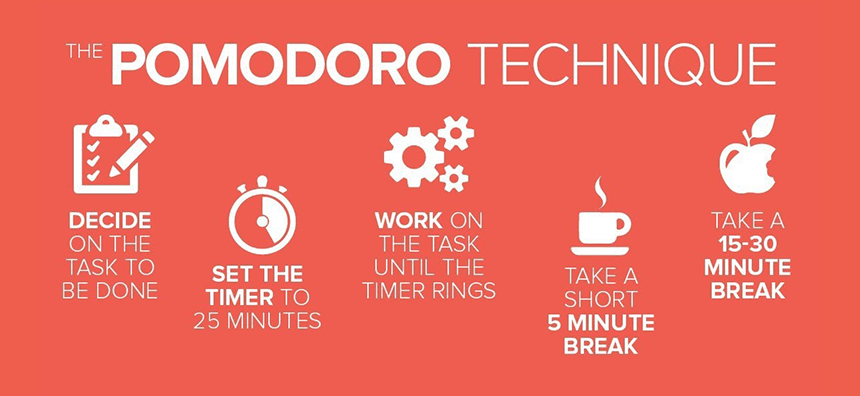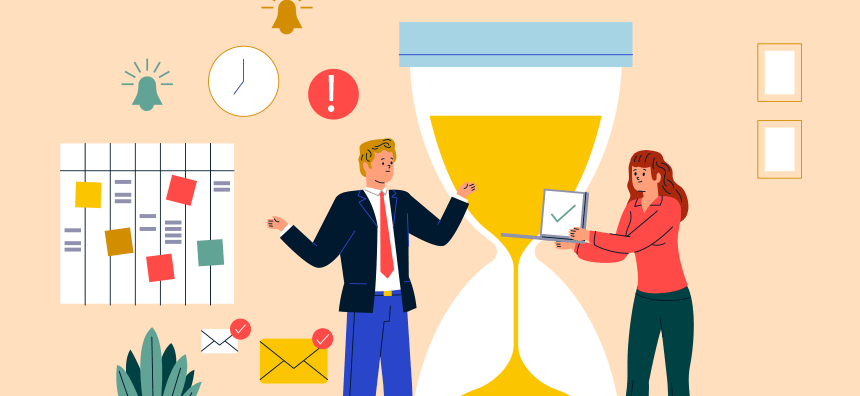
Click the button to start reading
A Simple Technique That Yields Big Results – How To Use Pomodoro To Maximize Productivity
The Pomodoro is a time-management technique that fights off procrastination and allows you to remain focused and productive throughout the day. It inspires continuous creativity, keeps you from feeling mentally fatigued, and provides an efficient way to get more done in less time.
The Pomodoro Technique uses a timer to break up our working sessions into intervals with short, but frequent breaks in between. The sprint sessions usually last about 25 minutes each and are immediately followed by 5-minute breaks. After you’ve completed four sets of these Pomodoros, you can then start increasing the duration of the breaks to last between 15-30 minutes, whatever timing you feel best feeds your productivity.
What is the Pomodoro Productivity Technique?
The Pomodoro Technique is a highly effective time-management method created by Francesco Cirillo in the late 1980s and is now used by people all over the world in a variety of professional and academic settings.
It’s a simple way to increase productivity and retain focus by challenging our beliefs about “time scarcity” – the concept that we have very little time (or resources) to successfully complete any of our given tasks or projects, which then creates a cycle of stress, indecision, and procrastination. The Pomodoro Technique promotes productivity by teaching us how to gain back control over our time — to work with the time we have rather than allowing time to work against us.
Inspired by the tomato (or “Pomodoro” in Italian)-shaped kitchen timer he used to implement this technique during college, he created a method that increases focus and reduces the feeling of burnout after long, intense stretches of concentration with little to no break, which is, unfortunately, the most common way we work or study.
How Does The Pomodoro Technique Work?
The basic structure of a Pomodoro productivity technique works like this:
- Choose a task that needs to be completed
- Set your timer for 25 minutes
- Work on the task
- Timer goes off
- Take a 5-minute break
- Continue this cycle until you have reached four rounds of Pomodoros
- After the fourth Pomodoro, you can take longer breaks, about 15-30 minutes — or whatever you need!

Overall, it sounds rather simple, right? Let’s see an example of a Pomodoro in action. Here is an example of how to implement this technique to help you sharpen your focus and get more done without feeling overwhelmed. Let’s take an assignment such as editing a paper.
- You’ve identified that the important task at hand is editing your paper.
- Either on your phone, kitchen timer, or app specifically designed to keep time, set a timer for 25 minutes.
- During the next 25 minutes, there should be no distractions. This means no social media, no TV, or any other type of disruption that can interrupt your focus.
- When the timer goes off, it’s time to step away from your desk. Try not to remain in the same space that you were working in. (Admittedly, this can be hard to do at first. Once you’ve started, it’ll be hard to stop. But the key to this technique is being consistent and trusting in the method. )
- Now that you’re taking your 5-minute break, truly take a break. Get a sip of coffee, watch a short video, or take a brief walk. Do anything but work. The important part is that you’re keeping your mind fresh, creating the space for new and inventive ideas instead of continually remaining in a state of continuous strain.
- Once the break is over, you repeat step #2 and begin your work again.
- The goal here is to do at least four bursts of work, each followed by a chance to pause.
- Once you’ve reached the fourth Pomodoro, you can start stretching your break to last longer. In this example of editing, you’ll likely want to take about a 30-minute break to feel recharged when you return to work.
- You can then continue this method throughout the workday or during a designated time specifically set aside for the task.
Of course, not every Pomodoro will proceed as smoothly as planned. At some point, you may have an emergency, need to take an important phone call, attend to your family, or answer questions from your coworkers.
If this happens, the Pomodoro session needs to be paused and restarted at a later point. Or, if the matter doesn’t demand your immediate attention, you can kindly let them know that you’ll be able to address the issue when you’ve finished the Pomodoro.
One of the most important aspects of the Pomodoro technique to remember is this: you’re not chained to the time constraints of this method. If you find yourself in the zone or are experiencing a highly creative flow when the timer goes off, you can pause the timer, finish your thoughts, and then take your break. You can modify your Pomodoro so that you are supporting your creativity and maintaining your productivity, while also giving yourself the time to take a break.
The Pomodoro technique helps make time your ally, instead of your enemy.

The Science Of The Pomodoro Technique
The effectiveness of the Pomodoro Technique is ultimately due to its simplicity. Its straightforward approach incorporates the benefits of consistent breaks and optimizes your cognitive capacity.
Several studies show that the average human attention span in working intervals is around 20 minutes. Pomodoros take advantage of this window and allow you to work in the most productive mind space.
According to a study done at the University of Illinois at Urbana Champaign, four groups were observed completing a 50-minute intensive task. The group that took more breaks actually produced more effective results. The same study also showed that short breaks increase concentration. The Pomodoro’s breaks — at least within the first four intervals — are relatively short at 5 minutes. This ensures you have a reliable cadence between your work output and the time needed to recharge. The frequency of the breaks matters and taking them — not working through them — is the key component of the Pomodoro technique. Using a timer can act as a “mini deadline,” which in turn, allows you to work towards your goal faster.
Taking breaks is actually conducive to creativity, bigger and better ideas, and quicker turnaround time. (Yes, you read that right!)

When To Use The Pomodoro Technique?
The Pomodoro Technique can be used by virtually anyone who works under tight deadlines, wants to increase productivity or creativity, and needs to reduce the occurrence of repeated procrastination.
With more and more people converting to either an exclusively remote work arrangement or a hybrid of in-person and virtual, we can’t deny that COVID-19 has changed the landscape of our working environment. Although there are a number of benefits to working remotely, our home surroundings and their many distractions are not exactly conducive to productivity. The Pomodoro Technique can be an advantageous method of getting things done effectively, make ample use of your time even in the absence of a traditional workplace setting, and allow you to procrastinate less.
The Pomodoro Technique can also be especially handy for dull or difficult tasks that usually leave us feeling unmotivated or intimidated. The 25-minute sprints help you get started by putting your thoughts on paper, followed by reminders that you need to take much-needed pauses. You can then return to the task a few more times feeling more encouraged than you did when you first began. Overall, these smaller commitments make assignments less daunting and still provide some breathing room, decreasing the amount of mental fatigue at the end of the workday.
People who find gamification particularly helpful or those who work well under pressure may also find the Pomodoro approach especially worthwhile.

Benefits of the Pomodoro Technique
One of the biggest benefits of the Pomodoro Technique is the ability to boost productivity and minimize distractions throughout the day. However, there are a number of other substantial benefits associated with this method:
- Crank through projects faster. Because there is an added layer of urgency, you can get through your task quicker by working effectively within the sprint.
- Keeps you from getting frustrated. The hardest part of an assignment is just getting started, especially when you’re already feeling unmotivated, frustrated, and overwhelmed. The Pomodoro helps you begin your work process and keeps you going at a steady rhythm.
- Minimizes procrastination. The promise of consistent breaks, and later customizing the breaks once you complete more cycles, allows for your mind to rest and check-in with other matters unrelated to work, which decreases the need to give attention to other distractions.
- Less fatigue. Focused sprints and ample time for breaks avoid the feeling of fatigue and inspire creativity. Because you’re likely moving around during the break and taking well-deserved time away from your computer screen, you’re less likely to have headaches or eye soreness.
- Makes planning out your schedule easier. Once you really start to embrace this technique, you can begin scheduling your week. For example, if you know you have a deadline due Friday morning, you can review your work week and decide how many cycles of Pomodoros will get the job in time (or before!) the due date.
- Boosts your confidence. Nothing feels better than getting a task done and crossing it off your to-do list. When you’re able to produce work in half the time and of the same high caliber, you’ll feel a boost in your confidence, motivation, and capabilities.
- Teaches you to prioritize. The number one goal of the Pomodoro Technique is to help you accomplish more of your goals. When you’re using this method, you’re prioritizing the task that you need to complete before any distractions that may be around you at the time. As we mentioned, some interruptions are unavoidable. But you’ll be able to easily discern what needs your attention versus what can wait and be addressed at a later time.
In Conclusion
For some of us, it can feel like there’s not enough time in the day to get anything done. We’re continually searching for ways to be more productive, creative, and efficient with our time.
The Pomodoro Technique is one of the simplest, yet most effective ways of boosting productivity. It’s a method that takes into account the science of giving yourself a break so that you’re ready to tackle the task in front of you, while also producing a significant bump in your work output. Give it a try and see if it works for you!
















